Canon Anti Aérien M1939 61-K 37mm
English Translation
Histoire
L’'armée et la Marine soviétiques à au milieu des années 30 ne disposent pas d'une seule pièce anti aérienne automatique
En URSS, dans le même temps de sérieux problèmes politiques se posent et tout va très lentement. Tout le travail reste focalisée par la Planification
Le 4 août 1935 Le décret C-101 C SRT donne l'ordre de construire un nouveau canon anti aérien et le 15 novembre 1939 Shpitalniy ingénieur ainsi que l’Usine N° 8 sont choisis afin de produire un prototype d'un canon automatique anti aérien de 37 mm
Le même décret stipule que le nouveau canon de 37 mm automatique anti-aérien devra tirer une munition ayant une vitesse initiale (V°) de plus de 1500 m / sec. Mais plus tard il a été autorisé après la construction du prototype de n’avoir comme V° que 1000 m / sec.
Le 13 mars 1936 la commande OK-KO 58ss arrive à l’usine N°8 pour une pré-production de 20 canons automatiques de 37 mm
5 canons pour T26 avec le système de visée du canon 20-K;
10 canons très similaires au canon Ginsburg76 mm 3-K avec leurs système de vision et de architecture de la pièce;
5 canons sur affut marin Vickers pour utiliser les moyens existants dans la Marine.
Pendant les essais, une série de vingt canons de 37 mm Shpitalniy sont installés sur un affût de canon 76 mm, le 3-K sur des plateformes de véhicules et le PT-10 sur la tourelle standard du T-26.
Mais rapidement, il s’avère que le T-26 n’est pas un char adapté à al luttes anti aérienne car il ne possède pas de débattement nécessaire Il ne peut agir qu’entre -7 °, 12 °.
La Commission tire donc à la fin de la série de test la conclusion que le canon de 37 mm canon Shpitalniy présentait certaines faiblesses de conception.
Gros efforts demandés aux tourillons et les renforcer augmenter le poids du système.
Automatisation trop exposée et pas au point ( frottements des joints mobiles.)
Système d'alimentation satisfaisant du à un mauvais usinage ( Les russes n’ont pas encore acquit les techniques nécessaires pour construire de telles pièces
En conclusion, le canons automatique de 37 mm Shpitalniy ne peut être retenu comme arme anti aériennes.
En Mars 1938, l’Usine n° 8 met au point le canon anti aérien de 37 mm 100K sous la supervision de 3 ingénieurs EV Charco, IA Komarickiy et LV Lyuleva. Mais l'organisation pour le développement de cette arme a été très confus.
L’automatisme du canon 100K fonctionne au détriment de la récupération de l’énergie des gaz par un alésage de la pièce trop important. L'énergie est produite à partir les gaz de combustion des obus .
La pièce maitresse du 100-K est un frein puissant qui a une efficacité d'environ 70%.
mais cette conception de frein fut ensuite rejeté par les ingénieurs qui ne laissent que le frein récupérateur extérieur.
En Avril-Mai 1938, le 100-K satisfait à des tests en usine, il a été monté sur l’affut quatre roues, chariot, du canon 49-K
Selon le rapport de la Commission de Décembre 1938, le système 100 K satisfait les spécifications requises, mais la Commission exige des modifications
Ces modifications ne touchent pas l’affut 49-K et 61-K .
Dans le même temps, à la fin de 1937, l'usine Kalinina sort son premier prototype de canon automatique ZIK-45 qui reçoit par la suite le nom de 49-K. Le nouveau canon est basé sur le 40 mm Bofors
Les travaux débutèrent en 1938 et cette arme fut appelée Canon 8 type Bofors
Le canon automatique 49 K fonctionne avec l'énergie permettant le court recul du canon. La fermeture de la culasse se produit lors de la récupération et permet de fermer celle-ci avant le départ du coup suivant.
Sur la culasse, on trouve un coin vertical.
L’alimentation du canon se fait aux moyen de lames chargeur de 3 obus mis en place manuellement
le frein hydraulique de recul, de type de broche est fixé sous le tube avec un récupérateur .
Le mécanisme d'équilibrage du canon de type pull-up type, se trouve placé de part et d autre de l’affut Le système de hausse est gradué et celui de rotation dans l axe est monté sur une roue dentée. Le tout fonctionne uniquement en manuel.
Lors des essais en usine au début de 1938, la cadence de tir 49-K a été 90/120 coups minutes avec un obus pesant 1.44 kg, pour une vitesse initiale - 9b0 m / sec. Mais des problèmes apparus lors des test retardent la production des engins à l usine de Tula
Le 20 avril 1938 lors de tir d'essai, à Sofrinskom après 70 départs de coups la température de la bouche du canon atteint 257 ° C, ce qui permet de déterminer la cadence de tir idéale qui sera de 60/70 coups minute.
D'autres éléments de l'automatisation permettent de a permis une grande longueur de la queue.
Par exemple, le recul de frein hydraulique du compresseur a été calculée chez tous les 150 coups.
En Juin-Juillet 1938 le 49-K est testé à l'époque avec l’affut lPT-10 monté sur un véhicule, Lors du test de Octobre à Décembre 1938 les obus atteignent une distance moyenne de 10946 m à un angle d'élévation de 44 ° 30 '. Mais ce résultat est purement anecdotique Toutefois les essais valident le tir avec affut sur roues
Après cet essai, la construction du 49-K subit certains changements
Cache flamme modifié et renforcé
Remplacement de la partie avant du tube afin d’accroître la durée de vie du tube.
De Juin à Juillet 1939, le 49-K est à nouveau testé
Le remplacement du tube prend 100 secondes
Mise en batterie (déplacement compris ) 30-40 minutes.
La cadence de tir reste la même: sous 'angle de 0 ° cela donne 140 coups / min et sous angle de 85 ° 120 coups / min.
En 1939, le 49-K est officiellement accepté sous le nom de canon 45-mm automatique Mdle.1939 arme de défense aérienne».
En 1940, l'usine N ° 8 recevoir une commande de 190 canons 49-K. Toutefois, dans le seconde moitié de 1940 suite à une décision de l'Armée Rouge toutes travaux sur les canons de DCA de calibre 25 37 et 45 mm sont abandonnées.
 |
Canon anti aérien 61-K
En 1939, le 61-K est accepté sous le nom de «Canon anti aérien de 37-mm obr.1939 « .
À la fin de 1939 l’usine N° 8 construit une série expérimentale de 15 canons automatique Mdle 61-K.
De Octobre à Novembre 1940 des test comparatifs sont effectués avec le canon suédois suite à la capture de 40 mm Bofors.
Les principales conclusions de la Commission sur les résultats de ces test prouvent la supériorité du 40 mm Bofors-gun sur le 61-K Afin d'améliorer la conception du 61-K celui-ci devra emprunter des éléments du canon suédois
Attelage Bofors
système de freinage,
architecture de la pièce
Système de visée
 |
La première commande de canon 37 mm 61-K est passée en 1940 pour 900 canons,
Le 1 Juillet 1940 on trouve 147 engins disponibles
En 1941, il est prévu de produire 1700 61-K à l'usine numéro 4.
L’Armée rouge se base sur 9132 canons 61-K, dont 1000 en réserve
La production de 61-K cesse en 1945.
En principe, 49-K et 61-K ont été les mêmes.
Mais le K61 est d’un entretien plus facile et le système d’alimentation automatique est fiable car lubrifié
Lors de déplacement le canon est sur affut ZU-7. L’affut possède des roues de GAZ-AA. Il peut facilement braquer grâce à un système d'équilibrage lui assurant une plus grande stabilité du canons
Pour passer de la position route à la position de tir les flèches sont dépliées
Lors de la séquence de tir l’ ‘équipe de pièce est forte de 5 hommes en général
Sur le côté droit le chef de pièce assure la visée en azimut
Sur le coté gauche le tireur assure le pointage en site et un autre vérifie l’alimentation qui Celle-ci bénéficie de 2 chargeurs qui se tiennent à l arrière.
Depuis 1943,le 61-K sera fourni avec un bouclier.
Données techniques
Calibre 37 mm
Equipe de pièce 5
Poids canons en position de tir (sans bouclier), 2100 kg
Vitesse / autoroute, km / h 60
Longueur du canon, KLB 6.26
Azimut -5 ° +85 °
rotation de 360 °
Vitesse initiale V° 880m/s
Cadence de tir, 160-170coups/m
Portée.
37-mm automatic gun 61-K 37-?? ?????????????? ????? 61-?
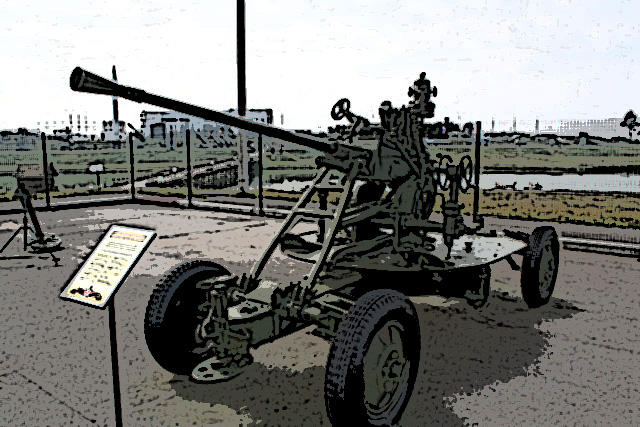 |
History
By the mid 30’s Soviet Army and Navy have not a single automatic anti-aircraft gun.
In the same time USSR have seriuous problems and all things are going very slowly. All work remains focused by the planification
On August 4th 1935 Decree number C SRT-101 C give and order to built a new anit aircraft gun and on Novembre 15th 1939 engineer Shpitalniy and plant number 8 was mandated to produce a prototype of an automatic 37-mm anti-aircraft guns.
The same decree, tell that the new 37-mm automatic anti-aircraft gun should be have a muzzle velocity of over 1500 m / sec. But later it was allowed to commence this work after the finalization of the sample produced 37-mm machine with a muzzle velocity of 1000 m / sec.
On march 13th 1936 an order number OK-KO 58ss plant number 8 detail the pre production for the first 20 automatic 37-mm cannon
5 guns for the tank T-26 with the sight of the gun 20-K;
10 guns in the truck could be seen on the construction Ginsburg 3-K with their arrangements and sight;
5 guns on marine pedestals Vickers using existing naval installations.
during the tests, a series of twenty 37-mm guns Shpitalniy were installed on a gun carriage from the 76-mm guns, 3-K on the cars and the PT-10 in standard turret of the T-26.
But quickly he appear that T-26 tank gun was no longer able to conduct anti-aircraft fire, as its angle of elevation was -7 °; +12 °.
At the conclusion the commission,of testing 37-mm cannon Shpitalniy had weaknesses of its design.
More effort to pins with a significant dynamic shoulder increases the weight of the system.
Details of Automation exposed at work is very large loads and friction in moving joints.
The power supply system is unsatisfactory and does not provide the requirements of practical rate of fire because of the rolling shop.
In Conclusion the 37 mm automatic cannon Shpitalniy cannot be recommended for adoption by the arms.
In March 1938, the plant number 8 was made 37-mm anti-aircraft gun 100K under the supervision of 3 engineers EV Charco, IA Komarickiy and LV Lyuleva. But the organizational for the development of the 100-K was very confusing.
Automatic gun 100K operate at the expense of energy gases bled from the bore. Power produced from the machine shop drum for 6 rounds. Barrel of the gun - a quick-piece.
The highlight of 100-K was a powerful slotted brake is active with the efficiency of about 70%. With this the brake engineers rejected brake rollback and left only the outer recuperator.
In April-May 1938, Cannon 100-K passed factory tests He was placed on four-wheeled cart, from the gun 49-K
According to the report of the commission from December 1938 the system 100 to satisfy the required specification, but required further work. Modifying its management of the plant is not wanted - Guns 49-K and 61-K with the competitors do not need.
In the same time in late 1937, the plant Kalinina was made the first prototype 45-mm automatic gun ZIK-45 (later received an index 49-K). The new gun was modeled on 40-mm Bofors and documents
Works began in 1938 and this gun was called gun factory number 8 type Bofors
Automatic 45-mm gun 49 to operate with energy in a short recoil during the trunk. The closure occurred during the rollback, and close after rolling barrel and next round.
On the cover is screwed breech, which was placed a vertical wedge bolt.
Feeding the machine was made with clips containing 3 rounds. Clip manually set the receiver over the receiver.
Brake hydraulic recoil, spindle type. Brake was attached to the bottom inlet pipe.
Spring recuperator was going on the trunk and was inside the neck cradle.
Balancing mechanism spring, swinging, pull-up type, consisting of two columns placed between the cheeks of the machine. The hoisting mechanism had notched sector. Swivel mechanism through the gears was associated with a toothed crown. Actuators guidance are only manual.
 |
At the factory tests in early 1938, the rate of shooting 49-K was 90-120 shots, shell weight 1.44 kg, muzzle velocity - 9b0 m / sec. Testing machine difficulties delayed the production of brass casings Tula factory.
On April 20th 1938 during test shooting, at Sofrinskom range after 70 rounds at the temperature of the barrel muzzle reached 257 ° C., heating the barrel to determine the length of continuous line 60-70 shots.
Other elements the automation allowed a large queue length.
For example, hydraulic compressor brake recoil was calculated in all 150 shots.
In June-July 1938 automatic 49-K was tested at the time with the carriage, mounted on a vehicle the PT-10.
During test from October to December 1938 shell obtained by the average distance of 10946 m at an angle of elevation of 44 ° 30'. But this result are purely sporting . During this test he shot with the four-wheel carriage
After this test the construction of the gun 49-K with some changes flash suppressor renforced spring rammer, replace the upper part of the gun carriage, reduced clearance to increase sustainability.
From June to July 1939 the 49-K was retested
Time to change the barrel 100 seconds
Time of transition from traveling to combat - 30-40 minutes.
Pace and rate of the gun - the same: when the angle of 0 ° - 140 rds / min at an angle of +85 ° - 120 rds / min.
In 1939, the gun 49-K was formally accepted into service under the name "45-mm automatic air defense gun Mdl.1939'. In 1940 the Plant N° 8 receive an order for 190 49-K guns . However, in the second half of 1940 was a final decision on the Red Army antiaircraft guns caliber 37 and 25 mm, and the work on 45-mm automatic guns were discontinued.
.jpg) |
Anti-aircraft machine 61-K
In 1939 61-K was put into service under the name "37-mm automatic air defense gun obr.1939 ."
At the end of 1939 the plant number 8 constructe experimental series of 15 automatic 61-K.
From October to November 1940 were conducted comparative tests of the gun 61-K with its prototype of the captured 40-mm Bofors.
The main findings of the commission on the results of tests of 40-mm gun Bofors' on the main HDT and operational qualities of advantages over the 61-K does not. In order to improve design gun 61-K should be completely borrow from Bofors' coupling, brake system, the location of the brake boots and fastening of the barrel. Sight Bofors' gun sight behind 61-K
.jpg) |
The first order of 37-mm gun 61-K was given in 1940 in the amount of 900 guns, of which 1 July 1940 has been deposited with 147 pieces,
In 1941 he planned to produce 1,700 guns 61-K (all at the factory number 4).
Total expected to have the Red Army in 9132 gun 61-K, 1000 of a mobilization reserve. Production machines 61-K for the towed guns ceased in 1945.
In principle, 49-K and 61-K were the same.
But it is better for maintenance and he has a reliable automatic fire systeme with a lubrication
.jpg) |
In combat and stowed position gun carriage was wheeled cart ZU-7. The wagon sprung, had a wheel of the GAZ-AA . The reverse wagon was tightly connected to the cap beam carriages, and to move forward and could turn with the balancer in the plane perpendicular to the cap beam, thus achieving greater stability of the guns on the march.
To transfer the system from traveling to combat gun was lowered on four pillars by turning the axes of the front and rear passages. Leveling guns carried by the four levels of jacks located at the ends of four cross-section housings carts.
During a fire on the platform of the machine was usually 5 men
On the right hand side the gunner on an azimuth and installer speed and range at gunpoint,
On the left - the gunner on an angle of elevation, the installer of the course and the angle of the dive o, and loader
rear loader.
Since 1943, 61-K was supplied with a shield.
Technical data
Caliber, mm 37
Crew, 5
Mass guns in firing position (without shields), 2100 kg
Speed /highway, km / h 60
Barrel length, KLB 6.26m
Azimuth -5° +85 °
rotation 360°
Muzzle velocity, m / s 880
Rate of fire, rds / min 160-170
Range max.
Voir Aussi See Also
Canon Anti Aérien M1939 61-K 37mm Cuba






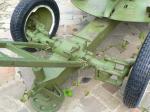
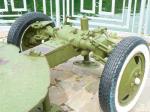
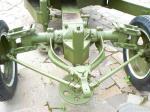
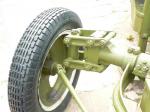
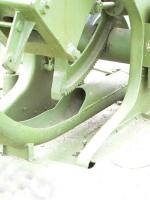
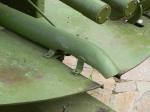
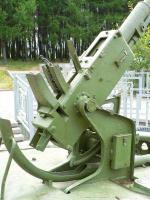
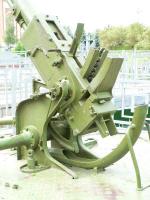
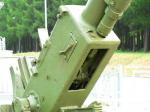
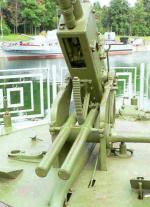
.jpg)






.jpg)

.jpg)


.jpg)
.jpg)
.jpg)